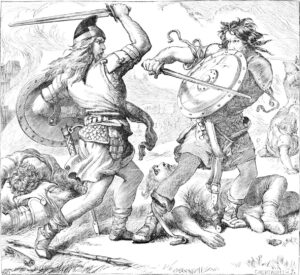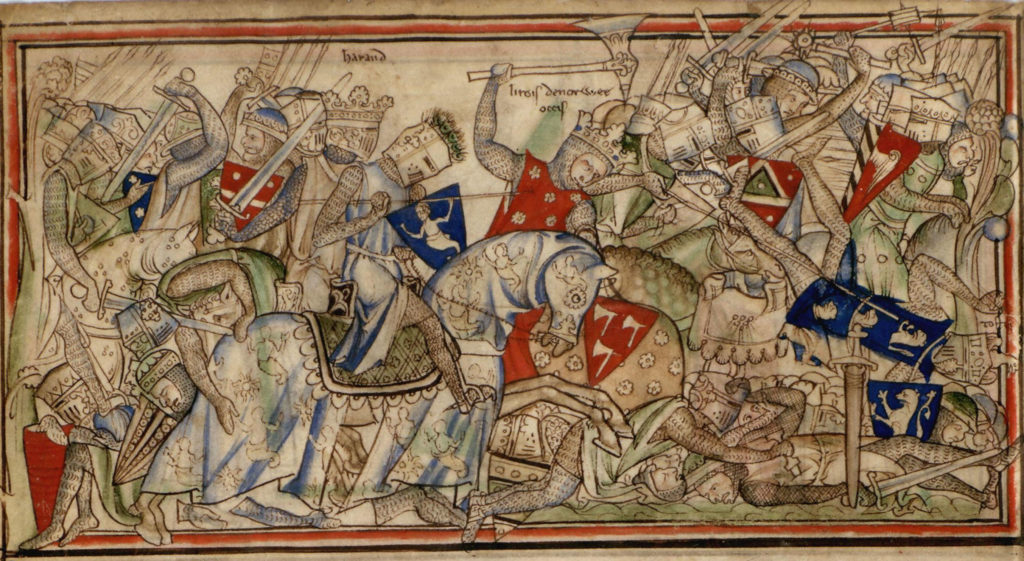 The friendship between Tostig Godwineson and King Malcolm of Scotland seems to have been largely overlooked, but it seems to me that it had a significant impact on Tostig’s career. When Tostig was made Earl of Northumbria in 1055, Malcolm had been unofficial king for a year or so. As usual, there is much confusion regarding this period, but it is thought that Malcolm reigned over Lothian—south of the Firth of Forth—and Strathclyde, or Cumbria. He would not officially be crowned while Macbeth lived, as Macbeth still ruled in the northern part of Scotland.
The friendship between Tostig Godwineson and King Malcolm of Scotland seems to have been largely overlooked, but it seems to me that it had a significant impact on Tostig’s career. When Tostig was made Earl of Northumbria in 1055, Malcolm had been unofficial king for a year or so. As usual, there is much confusion regarding this period, but it is thought that Malcolm reigned over Lothian—south of the Firth of Forth—and Strathclyde, or Cumbria. He would not officially be crowned while Macbeth lived, as Macbeth still ruled in the northern part of Scotland.
In 1054, Earl Siward of Northumbria invaded Scotland in conjunction with King Edward’s housecarls to put Malcolm on the throne. The invasion was very real; the battle of Dunsinane may have been apocryphal—though there was certainly a major battle somewhere. I was surprised to discover that Siward was not Malcolm’s uncle (did I get this from Shakespeare?). His interest in Malcolm was predominately political, for he was continually concerned about the safety of his northern borders. Historian William Kapelle (The Norman Conquest of the North) tells that before 1054, “both Edward and Siward must have hoped that as king he (Malcolm) would end the hostility that had characterized the northern border since 1006”. Kapelle tells us most definitely that “Malcolm did not hold Scotland as England’s vassal. He was king of Scots by inheritance and battle; his obligation to King Edward rested solely on gratitude.” Alas for Tostig, his gratitude was fleeting.
But that was later. When Siward died a year after the famous invasion—his heart broken by the death of his son in battle—the earldom of Northumbria was awarded to Tostig. There’s no evidence that Tostig had met Malcolm yet, but in 1057, the new Earl joined Malcolm’s final expedition against Macbeth. They tracked down and defeated the fleeing king at Lumphanan in Abersdeenshire; Macbeth allegedly died a few days later at Scone. According to Edward A. Freeman, King Edward’s biographer tells us that “Macbeth…was first defeated by Siward, then by Tostig.” (History of the Norman Conquest Vol 3, Appendix EE). So in some eyes, Tostig carried on the conflict begun by his predecessor. It seems he must have had a vested interest.
Tostig went on to create a very strong friendship with Malcolm. In 1059, Malcolm accompanied Tostig to King Edward’s court, probably at York (first visit by a Scottish monarch in 80 years). Somewhere in that time frame, Tostig and Malcolm became sworn brothers—blood brothers, as it were. This was a strong tie between rulers, but it seems that Tostig took it more seriously than Malcolm, for the Scots raided across the border whenever it suited them. These hostile acts culminated in 1061 when Tostig went on pilgrimage to Rome in support of his favorite Bishop, Ealdred, who expected to receive his pallium from the pope. Malcolm took advantage of Tostig’s absence to lead the most vicious of all raids deep into Northumbria, and even the sacred abbey of Lindisfarne was not spared. Tostig is accused to have responded to this outrage with diplomacy rather than reprisals, much to the dissatisfaction of his earldom. They seem to have thought him ineffectual in defending them, though according to Freeman, Tostig’s growing unpopularity made it hard for him to raise troops. This sounds like a vicious cycle!
Could it be that Tostig wanted to keep his friendship with Malcolm intact to ensure his welcome if the occasion arose? It’s hard to say, though he evidently had an uneasy relationship with the northerners since the beginning of his rule. It seems unlikely he knew what was brewing in his earldom in 1065, for he was frequently in the company of King Edward—and was accused of neglecting his earldom. When the terrible and well-planned revolt broke out in Northumbria and all 200+ of his household were killed, Tostig was once again in far-off south, hunting with the King. Ultimately he was forced into exile, and the next time he set foot on English soil he was an outlaw intent on revenge—or at least getting his earldom back through force of arms.

It was thought he was testing the waters, so to speak, in May of 1066 when he landed on the Isle of Wight with a handful of ships, mostly loaned from Normandy and Flanders. He worked his way around the coast of Wessex, impressing more English ships into service. After an aborted raid on Sandwich, he sailed north and stopped at the Humber, but earls Edwin and Morcar were ready for him and drove his little fleet back into the sea. At this juncture, most of his allies melted away, and he limped off with only seven boats in tow out of his accumulated sixty. This was when his friendship with Malcolm really gave him a boost, for the King of the Scots welcomed his sworn brother with open arms and reportedly gave him sanctuary for the rest of the summer. From this safe haven, Tostig is said to have recruited Scottish mercenaries as well as allies from the Orkney Islands, who were planning to join Harald Hardrada’s September invasion. King Malcolm did not accompany Tostig on his last campaign, but it is supposed he saw him off with a fond farewell.
I wonder if he said “good riddance” under his breath.